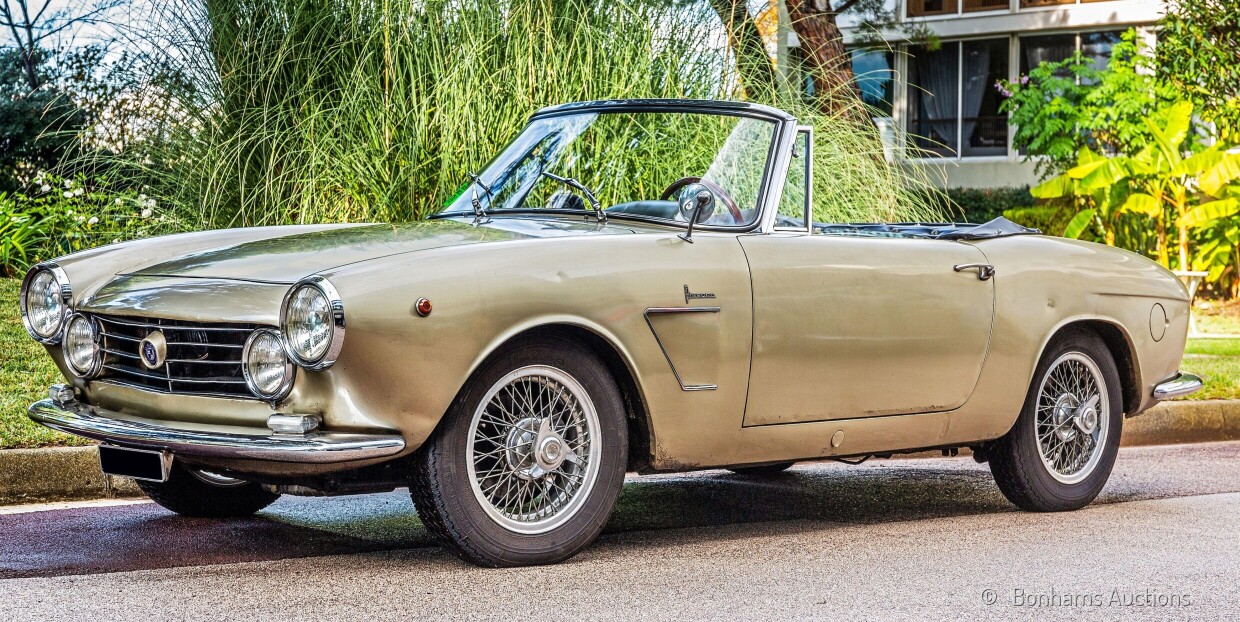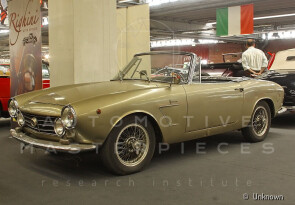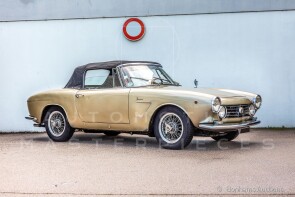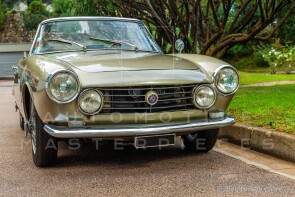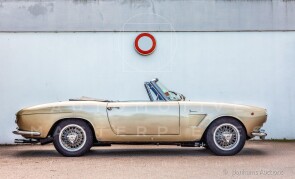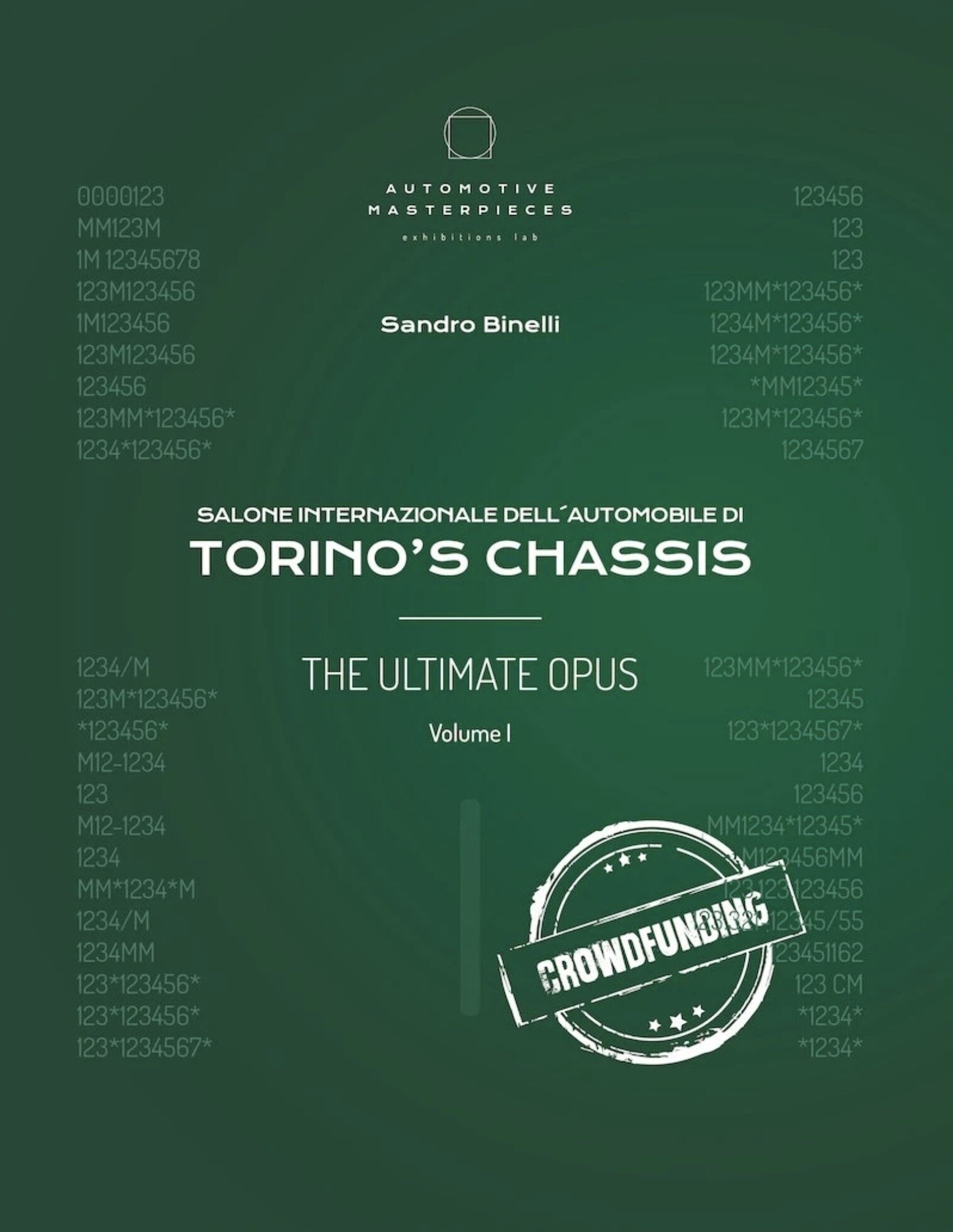
1964 Fiat 1600 S
ON/OFF
Why am I an Automotive Masterpiece?
In the 1950s, Fiat aimed to expand its range with models that combined elegance and sportiness in an accessible format. This line began with the Fiat 1100 TV Trasformabile, produced from 1955, a two-seater with a folding fabric roof and a special in-house developed body, featuring a sporty cut yet still with a traditional layout. This first experiment was followed by a more decisive shift with the Fiat 1200 Cabriolet, launched in 1959 and designed by Pininfarina, which introduced a modern and harmonious design inspired by contemporary Italian grand tourers. It featured a 1,221 cc OHV engine producing about 55 hp, resulting in a car that was pleasant to drive but not particularly brisk—more a touring spider than a true sports car. In 1959, to complement the 1200 and target a more demanding clientele, Fiat entered into a collaboration with O.S.C.A. (Officine Specializzate Costruzione Automobili), the small Modenese company founded by the Maserati brothers after selling the Maserati company to the Orsi family. As Fiat designer Dante Giacosa recounts in his memoirs, it was he himself who, following a meeting with Ernesto Maserati on July 11, 1957, at Mirafiori, proposed adopting the refined 1,491 cc twin-cam O.S.C.A. engine on the 1200 base. After a period of testing and adaptations, the Fiat 1500 S cabriolet was launched in 1959, retaining the Pininfarina bodywork of the 1200 but equipped with the new engine producing approximately 80–90 hp, capable of decidedly sportier performance. It was the first Fiat model officially powered by O.S.C.A., with an estimated production of several thousand units. Meanwhile, in 1961, Fiat introduced a new version, the Fiat 1500 Cabriolet (without the “S”), also styled by Pininfarina, with an all-Fiat 1,481 cc OHV engine producing around 72 hp, aimed at a clientele seeking more comfort than performance. This version, far more widespread, represented the natural evolution of the 1200, though lacking the mechanical sophistication of the O.S.C.A. variant. In 1962, the Fiat 1500 S (with the O.S.C.A. engine) evolved into the Fiat 1600 S, increasing displacement to 1,568 cc and output to 100 SAE hp, with a top speed of 175 km/h. It was also updated stylistically: the first series of the 1600 S retained single front headlights, while the second series, introduced in 1963, featured stacked dual headlights, a new grille, and redesigned bumpers. The interior was upgraded with a full Veglia instrument cluster and more refined details. The gearbox was a four-speed unit, with optional overdrive, while the braking system evolved from drum brakes to front disc brakes in the second series. The suspension setup remained independent at the front and with a solid rear axle. With a weight of around 950 kg and Pininfarina styling that closely resembled some Ferraris of the period, the Fiat 1600 S represented a refined balance of elegance and performance. Though not intended for racing use, it was appreciated for its technical exclusivity: it featured a twin-cam engine developed by true racing engineering specialists, within a mass-produced Fiat body. According to Giacosa’s memoirs, about 300 examples of the 1600 S were produced, but more recent and broader estimates suggest a figure between 2,000 and 3,000 units built from 1962 to 1966. According to a widely accepted estimate from multiple sources, 3,089 were produced, including all examples of the Fiat 1600 S (with 1.6-liter twin-cam O.S.C.A. engine), regardless of body type. The model’s career ended with the arrival of the new-generation 124 Spider, which would follow a different technical and stylistic path.
In addition to Pininfarina, many coachbuilders worked on the development of special versions based on Fiat spiders. Among them were Allemano, ASA, Bertone, Boneschi, Ellena, Fissore, Michelotti, Monterosa, Moretti, Savio, Scioneri, Vignale, Viotti, and Zagato. As for mechanical elaboration, notable names included Abarth, Breda, and Cellarosi. Carrozzeria Fissore was among the few to produce vehicles derived both from the Fiat 1500 S and 1600 S models equipped with O.S.C.A. engines, and directly from the O.S.C.A. 1600 GT with tubular chassis. The first prototype was presented at the 1959 Salone dell’automobile di Torino and was built on the chassis of the Fiat 1500 S. It was a coupé with a very aggressive appearance, featuring large wheel arches that highlighted the light alloy wheels manufactured by Amadori. The reception from both the public and the press was positive, and Fissore decided to begin production of the car, although it underwent a stylistic revision to eliminate some of the typical “show car” excesses. The roofline was raised to ensure sufficient interior space, the wheel arches were reduced in size, the width of the doors was narrowed, and other detail refinements were made. The first examples were delivered at the beginning of 1960. The car was also marketed in South America in a limited number of units through Cisitalia Argentina, under the name “85 DF.” Based on the Fiat 1600 S, in the autumn of 1962, Fissore presented a new version of the coupé at the Salone dell’automobile di Torino. The bodywork was completely redesigned, with softer and rounder lines (especially at the rear, which was completely different from Pininfarina’s fins), large glass surfaces, and a distinctive rear window split in the center. In this case too, a small production run was launched. The final version adopted dual headlights at the front and a grille with horizontal elements, reflecting the influence of the design changes Fiat had introduced in the meantime on its Pininfarina cabriolet. A spider version was added to the new coupé, essentially identical in the front and side views but without the fixed roof. Production of this special version ended in 1964 due to the high construction costs, which placed the car in a non-competitive price range. According to authoritative sources, including the Italian historic car register curated by John de Boer, Carrozzeria Fissore produced fewer than 25 total examples based on the Fiat 1600 S, including both coupé and spider versions. In particular, it is estimated that around 3 spiders were built.
The Fiat 1600 S with chassis 118SB*029454* is believed to be one of just three spider examples bodied by Fissore. The classification of this particular example has long been a subject of debate, due to its O.S.C.A.-derived mechanics, which, however, concern only the powerful twin-cam engine. Its identification as an O.S.C.A.-produced vehicle is incorrect, despite the presence of a likely non-original round O.S.C.A. badge on the grille replacing the original Fiat badge—visible in period photographs of the model—and despite the instrumentation (Jaeger rather than Veglia) bearing O.S.C.A. markings. The chassis is unequivocally the 118SB platform-type, used for Fiat 1600 S spiders with O.S.C.A. engines, and not the tubular chassis of the O.S.C.A. 1600 GT. Further confusion has been caused by references to this car under the names “Maina” or “Fissore-Maina.” In truth, Maina was not an independent coachbuilder, although Franco Maina can confidently be credited with the car’s design. Since 1959, he had been the head of Fissore’s design department, and it can be assumed not only that he was involved, but that he directly created the design of the car, which nonetheless bears the Fissore name on its flanks. The model was presented on Fissore’s stand at the 1964 Salone dell’automobile di Torino. It is not currently known whether the car on display was the one with chassis no. 029454: the aesthetic details are virtually identical—significant in the context of artisanal production—but the dark color of the car in the black-and-white photos taken at the show suggests caution in making this identification, since 029454 is today painted a lighter, aged gold color. Given the extremely limited production, the question remains open. It is considered plausible that only 2 or 3 Spider units were produced out of a total of 25 vehicles bodied by Fissore. According to documents, the car’s coachwork was completed in March 1964, it received a Fiat certificate of origin in April 1964, and was registered in Rome in May of that year (Roma 739740). In June, it was sold to its first owner: Giuseppe Di Rocco. The car remained for many years in the important collection of Mario Righini near Bologna, which allowed it to preserve its original and matching numbers condition.According to the registration history, the car was still in Italy in 2013, formally registered to its second owner, Paolo Carsi, since 1967. It was registered in France in July 2015 under the name of its new owner, André Binda from Nice, with license plate DT-141-LP. However, the French registration document contains some inconsistencies, such as the first registration date (1963) and the model name (1600 GT). The car was auctioned by Bonhams in 2019. It was described as “all original (chassis, body, paintwork, engine, transmission, electrics, etc), only the soft-top being new.” The car sold for a significant amount. Now is part of a private collection.
